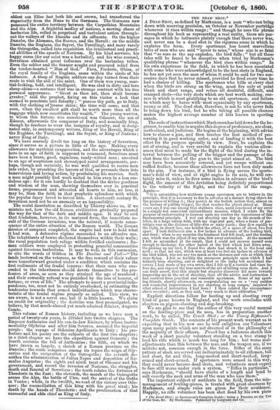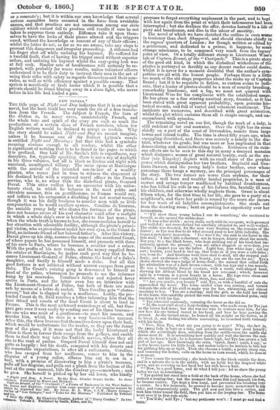THE DEAD SHOT. * A DEAD SHOT, as defined by Marksman,
is a man who can bring down with unerring precision, an October or November partridge whenever it rises within range ; " and though he uses the phrase throughout his book as representing a real entity, there are pas- sages in which he intimates plainly enough that there never was, and never can be a dead shot in the rigorous sense in which he explains the term. Every sportsman has heard marvellous tales of men who are said " never to miss," whose aim is so fatal that " so sure as the cap explodes, the bird falls ; " but all these tales will be found to be deceptive when tried by Marksman's qualifying phrase " whenever the bird rises within range." In his own experience in the field, in which he has been associated with some who were acknowledged.to be the best shots in England, he has not yet seen the man of whom it could be said for two suc- cessive days that he never missed, provided he fired every time he had a chance of killing. The sportsman who kills at every shot when the birds are strong on the wing, must fire only at point blank and short range, and refuse all doubtful, difficult, and cramped shots—the very shots which are best worth making, suc- cess in which is most gratifying to an old sportsman, and failure in which may be borne with• most equanimity by any sportsman, young or old. The dead shot, therefore, is not he who never fails to bring down his bird, but he who taking all possible chances makes the highest average number of hits known in sporting annals.
The code of instructions which Marksman has laid down for the be- ginner, to enable him to acquire this degree of proficiency, are clear, methodical, and judicious. He begins at the beginning, with advice how to choose a gun, and then teaches the best method of pre- serving it in good working order, and of loading it with the best effect for the purpose specially, in view. Next, he explains the art of aiming, and is very careful to explain the various allow- ances that must be made for the flight of the bird during the in- terval between the pulling of the trigger and the passage of the shot from the barrel of the gun to the point aimed at. The bird may have been accurately covered, and yet escape without one ruffled feather, because these allowances have not been duly made in the aim. For instance, if a bird is flying across the sports- man's field of view, and at right angles to its axis, he will cer- tainly miss it, unless he fires some inches in advance of the bird's flight, the amount of this deviation being definitely proportioned to the velocity of the flight, and the length of the range. Again— "It Is astonishing how stubborn young sportsmen are to believe in the principle, that it is necessary to fire in advance of a distant flying object for the purpose of killing it; they persist in the foolish notion that, almost on the instant of pulling trigger, the shot reaches the object aimed at. Many years ago I was one among that stubborn class, until convinced of my error in a simple but somewhat extraordinary manner, which I relate for the purpose of endeavouring to impress upon my readers the importance of this fundamental principle. I was out shooting one day in the month of Oc- tober, in a large turnip field, with my dogs and gun, when a brace of par- tridges rose at the distance of fifty-five or sixty yards ; they flow rapidly to the right, in direct line, one behind the other, at a space of about two feet apart. I took deliberate aim a few inches in advance of the leading bird, and fired ; when to my surprise the hindmost bird fell dead, and the leading one, which was the object of my aim,-flew away untouched. At the moment I felt so astonished at the result, that I could not recover myself soon enough to discharge the other barrel at the bird which had flown away. On picking up my bird, I found five shots had struck it in the head and neck ; so that my aim, which was at least two feet six inches in advance of the bird killed, was not any too much at the distance and rate at which they were flying. I felt so forcibly the erroneous principle upon which I had hitherto been shooting, and so delighted at the lucky but accidental dis- covery I had made of my own error, that I felt as if a curtain had risen be- fore me, and exposed the true secrets of the art of killing cross shots. And I can truly assert, that this simple but singular discovery did more towards improving me in the art of shooting, than all the advice and instruction I had received from practical and venerable sportsmen. Some of my sport- ing friends, shortly afterwards, on congratulating me on a very sudden and wonderful improvement in my shooting at long ranges,' inquired to what school of instruction I had been ? I then related the circumstance above recorded ; and, as they said, very much to their edification.' "
Explicit directions follow for beating up and shooting every kind of game known in England, and the work concludes with chapters on pigeon-shooting and dog-breaking.
We are glad to see that the author of this very useful manual on the fowling-piece and its uses, has in preparation another work, to be called, The Crack Shot ; or the Young Ilyleman's Complete Guide. The contents of his present work warrant us in expecting that in his new one he will enlighten our Volunteers upon many points which are not dreamed of in the philosophy of the majority of their officers. Punch has a ludicrous sketch this week of a short punchy volunteer standing on a tree stomp to load his rifle which is much too long for him ; but worse mal- adjustments than this between the man and the weapon are, if we mistake not, common enough in the force. Rifles of the same pattern of stock are served out indiscriminately to all riflemen, tall and short, fat and thins long-necked and short-necked, long- armed and short-armed. If sportsmen were armed in this way, they could never become dead shots, and volunteers must expect to fare still worse under such a system. " Rifles in particular," says Marksman, "should have stocks of a length and bend to suit exactly the neck and arms of the man who uses them."
The important subject of accidents in the field, from the mis- management of fowling-pieces, is treated with great clearness by Marksman, and simple rules are given for their avoidance. Happily, no rifle volunteer has been shot dead by his own piece
• The Dead Shot; or Sportsman's Complete Guide : being a Treatise on the irse of the Gun, &e. By Marksman. Published by Longman and CO.
or a comrade's ; but it is within our own knowledge that several serious casualties have occurred in the force from avoidable causes, and that practices are not uncommon among our civic soldiery which cannot fail to produce evil results if care be not taken to suppress them entirely. Riflemen take it upon them- selves to have the locks of their pieces altered and the triggers eased, without the knowledge or consent of any of their officers ; whilst the latter do not, so far as we are aware, take any steps to prevent this dangerous and irregular proceeding. A rifleman had his finger shot off while unfixing his bayonet. He suffered for a twofold fault, that of having his trigger eased without superior orders, and unfixing his bayonet whilst the easy-going lock was at full cock. Similar acts of heedlessness will certainly be re- peated, with probably far worse results, unless volunteer officers understand it to be their duty to instruct their men in the art of using their rifles with safety as regards themselves and their com- rades, as well as with efficiency against a possible enemy. That system is manifestly at fault under which it is possible that a private should be found blazing away in a sham fight, who never before in his life had loaded a gun.



























 Previous page
Previous page